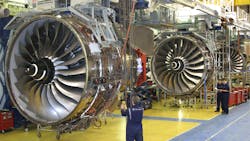Case study: IFS and Rolls-Royce connect the automated data pipeline
In 2019, IFS partnered with airline engine manufacturer Rolls-Royce to apply their combined artificial intelligence (AI) expertise and improve predictive maintenance on engines in the field. The result is a new analytics maintenance model that could be applied to after-market maintenance in many industries or onto factory assets themselves.
IFS makes enterprise software that is focused on enterprise resource planning (ERP), asset management and field service maintenance solutions. Airline customers use IFS software to monitor engine maintenance and service for operation and government regulations. “We have a system for airlines to track all of their aircraft and make sure that their aircraft are air worthy and compliant and that they’re doing all the maintenance that they need to do on those aircraft,” says Rob Mather, vice president of aerospace and defense industries at IFS.
A leader in servitization, Rolls-Royce has been providing maintenance services since the early 1960s to its aerospace customers through the TotalCare program. Today, the program is usage based, charged on a fixed dollar per flying hour basis, and it continues to alleviate the burden of engine maintenance from customers.
In 2018, Rolls-Royce initiated its IntelligentEngine digital twin program to predict real-time component usage and lifetime with AI modeling, seeking engines that are connected and contextually aware. Rolls-Royce also works with many of the same airline customers as IFS. To start the IntelligentEngine digital twin program on its Trent 1000, Trent XWB and Trent 7000 engines, Rolls-Royce would need continuous and more accurate access to data on engine use. Data initially came from customers, who periodically extracted data from their systems and uploaded spreadsheets.
With the knowledge that they shared airline customers, Rolls-Royce approached IFS to help automate this data flow, which could cut down the time to collect data and improve data accuracy. By the end of 2019, they had an official partnership in place to harness the continuous data needed for AI-powered predictive maintenance. “We have built an automated data pipeline from our customers into Rolls-Royce, so that they can get real-time or near real-time in-service status of the assets that they’ve built,” Mather says.
This automated data pipeline from the customer combines with Rolls-Royce’s sensor data and other information for data analysis, and then results feed back to the customer. Rolls-Royce has coined the back-and-forth flow of real-time data the Blue Data Thread. The concept enables end-to-end sharing of data back and forth between the airline customer and IFS and Rolls-Royce, helping to support maintenance throughout the product lifecycle.
How Blue Data Thread powers AI-enabled predictive maintenance
Airline engine manufacturers and operators must adhere to specific guidelines for component use and replacement. Those guidelines for engine life and the life of each component are precisely calculated, so users know exactly when to replace each component or perform other maintenance. Traditionally, this is done through a long process of equipment testing and many calculations, including worse-case scenario considerations and other safety factors, in order to estimate a very conservative engine lifetime value.
The Rolls-Royce / IFS partnership, however, enabled the collection and management of reams of data and automated workflow that make AI-enabled predictive maintenance possible. “What we’re doing with the information that we’re passing onto Rolls-Royce is providing the context for how the asset was actually used in the field, how each individual engine was actually flown,” Mather says. “IFS is providing all of the configuration and contextual data regarding the life limited components on the engine (i.e., what component went on when, what usage was accrued on that specific component while it was installed).”
This is integrated with all the sensor data from the engines, as well as other information like flight data and external conditions, such as weather and temperature, to evaluate engine condition and the true remaining life of the asset. The data analysis doesn’t estimate equipment lifetime; instead, it knows the usage and maintenance needs through data analysis that would only be possible with artificial intelligence.
Rolls-Royce customers configure and filter the data feed on their side. “The parameters that we can track against the engine are unlimited. They’re fully configurable by the airline customer,” Mather says. Asset life is often measured in terms of hours and cycles used, but the IFS system can also look at different parameters, such as temperature. “When you start having multiple variables going in and coming out, it means that Rolls-Royce’s offering can be more robust. They have more data points, and they have the ability to automate the output that they generate for their customers,” Mather says.
The maintenance update feed from Rolls-Royce goes automatically to the airline customers’ IFS system, which converts into scheduling information with updated forecasts on maintenance due dates. “Predictive maintenance models are all backwards looking, right? That's the historical analysis. And then the next level is when you get the sensor data, and you're doing the anomaly detection to contextualize it around what's actually happening on this specific asset,” Mather says.
Wider industry application of an AI-driven maintenance analytics model
Rolls-Royce’s IntelligentEngine program is also setting a direction on how industry in general might combine analytics on both physical and digital assets to inform data-driven decisions about maintenance, both for individual customers but also on a wider enterprise scale. The access to massive amounts of customer data all fed to the IntelligentEngine creates the opportunity for AI to build and learn from that database of information.
The forward-looking projections for engine maintenance are important in a tightly regulated industry, which requires tracking engine hours and engine cycles. The initial life limits on an engine design use a standard duty cycles concept, meaning setting an expected life under normal conditions. ”The normal engine cycles (i.e. 1 cycle = 1 flight) is baked in as the worst-case scenario (flying hardest in worst conditions). Standard Duty Cycles (SDC) are always representative of how the engine components have worn less than that worst-case scenario, so SDC is never larger than default cycles,” Mathers says. Rolls-Royce uses AI to take the as-flown usage, conditions and performance data and calculates the equivalent SDCs. With that calculation, IFS can project out the maintenance deadlines or the life of the components.
OEMs can analyze data for the individual operator, but they can also contextualize that data on a broader data set. “They’re not just examining the performance of one customer’s engines, they’re analyzing the performance across their fleet engines to notice trends,” Mather says.
This maintenance analytics model also could be applied to after-market maintenance in many industries or onto factory assets themselves. Research indicates that up to about 80% of the money spent on very complex assets, Mather says, is all maintenance and repair activities. “A lot of OEMs that make something realize that there’s more money to be made in the aftermarket,” he adds. Rolls-Royce has turned the TotalCare platform into a subscription service, based on the engine hour usage. “They’re guaranteeing the availability of the engine,” he says.
The IFS AI infrastructure is based on the concept of a shared compute platform with data residency guarantees. “Our [machine learning] ML service is a shared service with complete separation of storage and compute. No long-term storage of any client information is part of the service. There is, however, an internal data lake to store information as part of the ML service internal processes,” Mathers says.
The time series and anomaly detection services are part of the IFS asset performance management (APM) solution, which also includes a data preparation service, deploying a dedicated data lake storage infrastructure to process the client’s telemetry data. A data lake infrastructure can aggregate real-time sensor data and many other data formats into valuable data assets. “The lake itself is the repository,” Mathers says. Sometimes it can be a challenge receiving different data sets from different sources and making that data useful in a super structured database.
“When you have a data lake, you basically pour data into it from all kinds of different sources, and it becomes a less structured pool of data. And then you rely on tools that can analyze that data in that less structured format, to be able to get to your insights,” Mather says. “It’s hard to have data without structure without something like AI to be able to help you interpret it.”
About the Author

Anna Townshend
managing editor
Anna Townshend has been a journalist and editor for almost 20 years. She joined Control Design and Plant Services as managing editor in June 2020. Previously, for more than 10 years, she was the editor of Marina Dock Age and International Dredging Review. In addition to writing and editing thousands of articles in her career, she has been an active speaker on industry panels and presentations, as well as host for the Tool Belt and Control Intelligence podcasts. Email her at [email protected].


